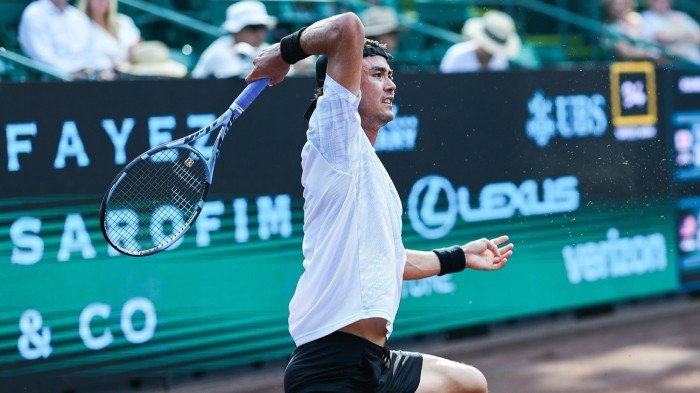Unlock the Editor’s Digest for free
Roula Khalaf, Editor of the FT, selects her favourite stories in this weekly newsletter.
The winners of Wimbledon this year will walk away with £3mn each. But down the pecking order, for players outside the top 100, just breaking even each week can be a challenge.
Japanese player Taro Daniel is hovering around the 150 mark, and has experienced the highs and lows of life on the tennis tour over the past decade. In 2022, he had the standout win of his career beating Andy Murray to reach the third round at the Australian Open, pocketing nearly $150,000 for a week’s work. But he has also spent time scrimping and saving.
Like many players at his level, Daniel spent years sharing hotel rooms, losing money each week, and missing out on the (relatively expensive) nutritious meals that athletes need. “When I was younger, I even wouldn’t get the avocado on my Chipotle order because it’s like three dollars more. When you try to save too much it ends up impacting people’s games negatively,” he says.
More from The Business of Tennis
Daniel won $180,000 in prize money in the first six months of the year, but he says it can be quickly eaten up by costs. “That figure you see, is super not real,” Daniel says. “First of all, you’re earning all of this money from foreign countries so they’re going to take all the withholding taxes from [it]. Then, tournaments cover your hotel room, but they don’t cover your coach’s hotel room.
“My credit card statement, it’s at least $20,000 a month on just operational expenses of hotel, food, flights and not including the salaries I pay to my team . . . As a tennis player you’re like a small company, but having all your employees travelling all the time.”
A salary for a travelling coach at Daniel’s current ranking level would be at least $50,000, he says, plus they would usually earn 10 per cent of prize money in commission. “So at least $100,000 per season for your basic level, not super experienced coach,” he says.
“Ten years ago, when I started, a lot of players would travel alone because the standards were not as high. Now, it would be very rare for someone to travel alone to a Grand Slam for example. Everyone has a coach or trainer. They’re probably right on the red-black line . . . even in a Slam you’re not necessarily making money.”
When it comes to getting to and from tournaments, Daniel says he is “scared to count” how much he spends on travel.
He is not alone. Tennis journeyman Dustin Brown famously travelled and slept in a camper van for three seasons at the start of his career.
The P&L account: Ballpark figures
Costs per season
Coaching: $50,000
Coaching bonus: $70,000
Physical/strength coach: $50,000
Extra staff costs: $10-30,000
Travel and expenses: $240,000
TOTAL: $440,000
Earnings per season
Prize money: $500,000
Racket sponsor: $20,000
Shirt sponsor: $50,000
TOTAL: $570,000
Pre-tax figures for players ranked around 100.
Source: Taro Daniel
Players’ schedules can change quickly depending on their results, so they often book flights at the last minute when prices soar. “Let’s say you’re going from Indian Wells to the Miami Open,” Daniel says. “That flight is going to cost $500 at least, most players will bring two other people like a coach and physio, and then extra baggage for rackets and kit. It would be about $2,000 for one domestic trip. One way.”
Daniel is Japan’s number 3 men’s player, and has previously reached as high as 58 in the world rankings. But it is the recognition he gained from big wins over Murray and Novak Djokovic — rather than his progress on the second tier Challenger tour — which has helped him supplement his earnings with sponsorship deals.
“People can understand, OK you were a serious pro,” he says. “Instead of, ‘you won 20 Challengers’ — which, by the way, is amazing — but they’re like ‘what’s a Challenger?’”
Circumstances can change though. While Daniel has played in arenas of 10,000 in Melbourne, he calls the Financial Times from a small Challenger event in Perugia, Italy. He pocketed €3,000 for reaching the last 16.


At 32 years old, he has built a big enough cushion to not worry about a bad week of results. But young players outside the top 100 may never earn enough to gain that peace of mind, and prize money is much lower at many women’s tour events.
The Professional Tennis Players’ Association began legal action against tennis’s governing bodies earlier this year, and prize money was one of their main concerns.
Daniel says sharing more of the pot with lower ranked players would help. “The Grand Slams gross like $350mn to $500mn a year. I think the solution would be for every player up to 300 or 400 in the rankings to be given a $100,000 stipend, divided by the Slams and the ATP or WTA. It would be $8mn from each organisation, that’s not unreasonable.”
FT Scoreboard

Scoreboard is the FT’s weekly briefing on the business of sport. Sign up at ft.com/scoreboard
The ATP launched its Baseline financial security programme in 2024. It ensures minimum annual earnings of $300,000 for players inside the top 100, $200,000 for 101-175 and $100,000 for players between 176 and 250. It paid out $1.3mn to 26 players in its first year.
“To date, Baseline has been funded solely by the ATP,” a tour spokesperson said. “With broader support from across the tennis ecosystem — including the Grand Slams — there is clear scope to raise these thresholds.”
Daniel says there is too much of a gap between what the top players earn and their lower-ranked rivals. Higher ranked players, “have an extra level of support”, he says, enabling them to recover from one match and prepare for the next more quickly. “If you’re lower ranked you’re winging it.”




